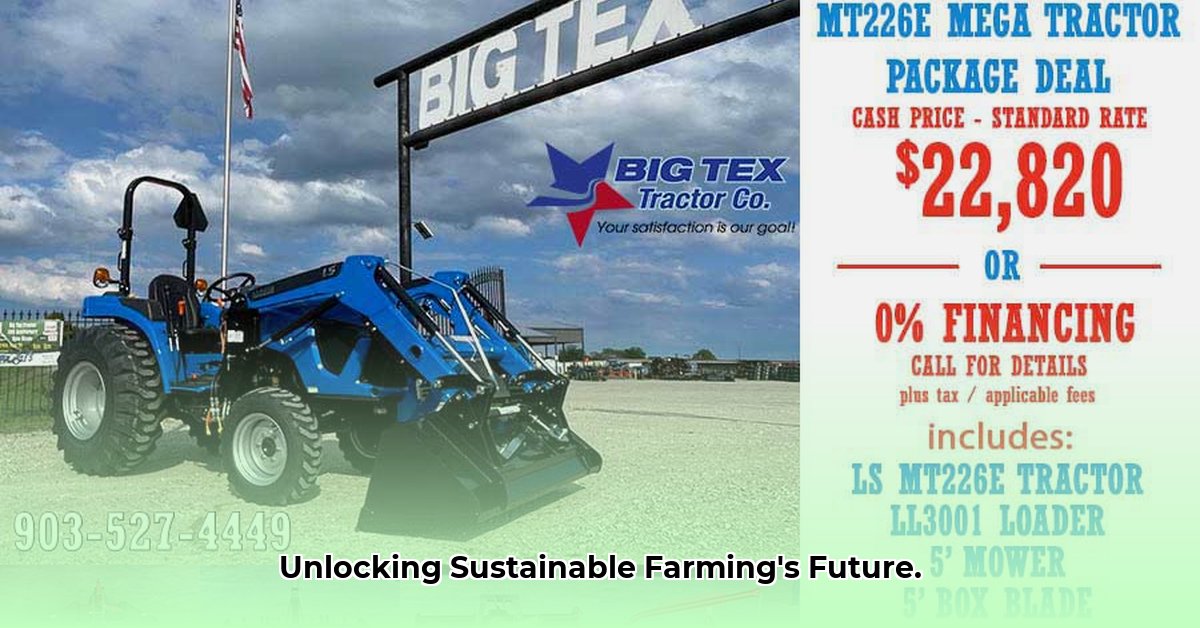
Tractor Finance for Sustainable Agriculture: Navigating the Landscape
Buying a tractor is a significant investment for any farmer, especially those committed to sustainable agriculture. While the benefits of eco-friendly practices are clear, securing the necessary financing can present unique challenges. This article serves as a comprehensive guide, helping you navigate the complexities of tractor finance and secure the best deal for your sustainable farm. We'll explore the current financing landscape, offer actionable steps to find the right loan, and highlight resources to support your sustainable farming endeavors. Did you know that a lack of transparency in tractor financing makes it difficult for farmers to compare deals effectively? For more resources, check out this helpful guide on tractor financing options.
The Current State of Tractor Financing
The market for farm equipment financing is currently fragmented and lacks transparency. While major manufacturers like Kubota and KIOTI offer in-house financing options, comparing these offers can be challenging due to variations in interest rates, repayment terms, and additional perks. This lack of standardization makes it difficult to determine the most cost-effective deal. Furthermore, dedicated financing for sustainable agricultural equipment remains relatively scarce, despite the increasing demand for eco-friendly farming practices. This gap presents a significant hurdle for farmers investing in sustainable technologies. "The current market presents a significant challenge for sustainable farmers seeking financing," says Dr. Amelia Hernandez, Agricultural Economist at the University of California, Davis. "The lack of tailored financing options specifically designed for sustainable equipment often leads to higher borrowing costs and longer repayment periods."
Securing the Best Tractor Loan: A Step-by-Step Guide
- Conduct Thorough Research: Begin by comparing financing options from various tractor manufacturers, including Kubota and KIOTI. Analyze interest rates (the cost of borrowing), repayment schedules (the duration of the loan), and any special offers or incentives. Remember to carefully review the fine print to fully understand the terms and conditions.
- Compare Loan Offers: Create a spreadsheet to compare the key features of different loan offers head-to-head, such as interest rates, monthly payments, total amount repaid, and any additional fees. This allows for a clear, objective comparison of the total cost of each loan. Don't overlook the total cost of the loan; it often reveals surprising differences.
- Assess Your Farming Needs: Define the type of tractor you need, your budget constraints, and your long-term farming goals. This will help you narrow down your choices and ensure your equipment meets your specific needs and budget. Many farmers underestimate initial costs and fail to plan for long-term maintenance.
- Explore Subsidies and Grants: Investigate government agencies and organizations offering financial assistance to farmers adopting sustainable practices. These programs can significantly reduce your financing needs and overall costs. The USDA, for example, provides numerous programs that support sustainable agriculture.
- Negotiate Loan Terms: Don't hesitate to negotiate loan terms with lenders to secure the best possible rates. Remember that you are a valuable customer. Effective negotiation can often lead to improved interest rates or additional benefits.
- Thoroughly Review Loan Documents: Carefully read all loan documents before signing. If any terms are unclear, seek clarification to avoid any unforeseen issues. This crucial step safeguards your interests and prevents future complications.
Overcoming the Hurdles of Sustainable Farming Finance
The limited availability of financing specifically designed for sustainable farming equipment presents a significant challenge. However, several strategies can improve your chances of securing favorable loan terms:
- Highlight Your Sustainability Commitment: In your loan application, emphasize your dedication to sustainable agricultural practices. Explain how your methods are environmentally friendly and contribute to long-term farm sustainability. This can positively influence lenders' decisions.
- Bundle Equipment Purchases: If you require multiple pieces of equipment, consider bundling the financing for all purchases. Lenders often offer more favorable terms for larger loans. This approach can yield significantly better interest rates and payment plans.
- Utilize Government Programs: Actively research and apply for government programs, subsidies, and grants supporting sustainable agriculture, significantly reducing the required loan amount. These programs are designed specifically to assist farmers in adopting sustainable farming practices.
Planning for Long-Term Success in Sustainable Farming
Sustainable farming is a long-term endeavor, and your financing plan should reflect this commitment. While shorter loan terms may offer lower monthly payments, longer-term loans, even with potentially higher overall interest, can be easier to manage over the equipment's lifespan. Remember that the long-term benefits of sustainable farming, including increased efficiency and reduced environmental impact, often outweigh the initial investment.
Actionable Checklist for Securing Tractor Financing
| Action Item | Timeframe | Expected Outcome |
|---|---|---|
| Obtain quotes from at least three lenders | 1-2 weeks | Compare interest rates, repayment terms, and additional features |
| Research relevant grant and subsidy programs | 2-4 weeks | Identify potential funding sources for sustainable equipment |
| Submit loan and grant applications | 1-3 months | Secure necessary financing for your sustainable equipment |
Securing the right financing is crucial for the success of your sustainable farming operation. By following these steps and leveraging available resources, you can successfully navigate the financing landscape and embark on a path towards a profitable and environmentally responsible future. Remember, thorough planning, persistent research, and proactive engagement are key to securing the best possible financing for your sustainable farm.